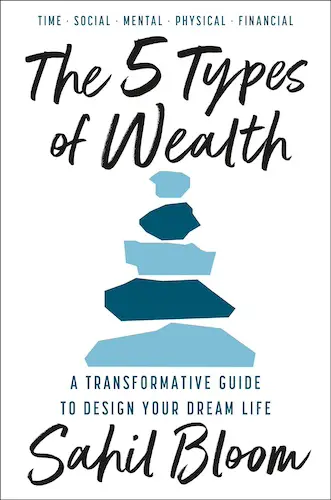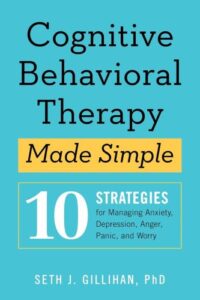
Date Published: February 4, 2025
The 5 Types of Wealth
Book Author: Sahil Bloom
Summary reviewed by:
Terrence Timmons
Terrence Timmons
Analyst
Bachelor of Arts (BA), University Of California, Santa Barbara 2019
With over 4 years of experience as an analyst. Terrence Timmons is committed to analyzing summaries without compromising on quality.
The 5 Types of Wealth: Summary
Brace yourself: everything you think you know about “wealth” might be wrong. In The 5 Types of Wealth, Sahil Bloom challenges the misleading narrative that money alone defines success. Drawing on insights from fields like psychology, physiology, and a landmark Harvard study revealing the link between meaningful relationships and long-term health, he shows that true fulfillment requires building five forms of capital: Time Wealth, Social Wealth, Mental Wealth, Physical Wealth, and Financial Wealth. Bloom’s qualifications as an entrepreneur, investor, and writer—alongside thousands of interviews—bolster his authority in blending personal stories with evidence-based methods. The book underscores practical, everyday approaches to personal development rather than lofty ideals. By adopting Bloom’s strategies, readers learn how to reject default choices, prioritize what matters most, and achieve lasting happiness without sacrificing their well-being.
Bloom warns of the “arrival fallacy,” the trap where we believe joy lies in that next promotion, salary jump, or external marker of success. He also highlights the “enough” mindset, reminding us that financial progress feels hollow if expectations always outpace achievements. To maintain a well-rounded life, he recommends the “dimmer switch” principle: instead of shutting off vital domains like health or relationships, keep them on “low” even when career ambitions peak. The “life razor” idea—one clear guiding rule—helps simplify choices and protect core values under pressure. Bloom’s framework actively counters burnout by teaching readers to recognize that any gain above zero compounds in a positive direction.
Beyond theory, Bloom offers straightforward tools and exercises: a monthly “life dinner” to strengthen relationships, a quick “Feynman technique” to master new skills by teaching them to someone else, and simple physical-health routines emphasizing movement, diet, and rest. For everyday application, he advocates short texts or calls to maintain social ties, blocking out “sacred” hours for meaningful activities, and defining personal boundaries that preserve mental clarity. The result: an actionable roadmap to incrementally improve each wealth type, even during life’s busiest seasons.
This book’s promise is both simple and revolutionary: build a life based on holistic wealth rather than chasing money alone. By confronting deeply embedded illusions about status and success, readers can shift their focus toward sustainable happiness. The payoff, according to Bloom, is genuine freedom—time spent on purpose-driven work, flourishing relationships, optimal health, and financial security on your own terms. If you’re ready to reject the default path and reshape your future, The 5 Types of Wealth provides a clear, realistic guide to designing a truly abundant life.
The 5 Types of Wealth: Genres
Nonfiction
Self-Help
Personal Development
Personal Finance
Wellness
Time Management
The 5 Types of Wealth: Themes
Time Wealth
Bloom encourages shifting focus to how hours are spent each day. He illustrates the value of prioritizing family interactions, such as deciding to live closer to aging parents, showing how to reclaim control over life’s most precious asset.
Social Wealth
Emphasis is placed on nurturing deep relationships. A monthly “life dinner” is described, in which couples and loved ones openly discuss joys, concerns, and long-term aspirations to build lasting bonds.
Mental Wealth
Purpose and clarity are highlighted. Bloom references the “arrival fallacy,” where people chase goals believing fulfillment lies just ahead. He advocates identifying personal purpose—whether raising a family or launching a business—and sustaining it through genuine curiosity.
Physical Wealth
Movement, nutrition, and rest form the basis for lifelong health. Bloom underscores daily activity, unprocessed foods most of the time, and consistent sleep routines. He shows how incremental progress in these areas protects well-being for the long haul.
Financial Wealth
Financial freedom is reframed with the “enough” mindset. Bloom describes how individuals can establish a personal benchmark of security and satisfaction, rather than endlessly increasing material desires, ensuring that money serves life’s greater priorities rather than consuming them.
Integrated Balance
He reminds readers that none of these areas should switch off entirely while focusing on another. By setting small, consistent habits—such as a quick text to a parent or a short daily walk—each domain can continue growing without sacrificing the others.
The 5 Types of Wealth: Methodology
In creating this summary, we started with a clear focus on you the reader, ensuring that concepts like time wealth and the arrival fallacy speak directly to your journey. We then applied deep research across diverse fields—finance, psychology, and wellness—to distill crucial insights on building healthier routines and forging stronger bonds. Finally, we condensed these findings into a concise format, spotlighting Bloom’s core messages, such as prioritizing small daily actions for physical health and defining your own version of “enough” to avoid endless financial pursuits.




